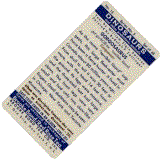 |
|||
|
|||

|
|
|
How does the printer get those cards to Red Rose? They put them in bricks. Bricks of 10 sets in a "sleeve".
According to my friend Marcel, they receive the bricks at the Red Rose factory and load them into the machines that spit the cards
into the box like a magazine on a gun. Way cool!
If you have had any access to the Red Rose bricks at all, you would note that the original Brooke Bond Red Rose bricks ('59 to '74) had a
sleeve around the cards along with a plug on each end and a rubber band. The new Lipton Red Rose bricks from 1990 to 1991 appear to have
lost the plugs on the ends. I asked Marcel (Operator of Fairfax Packaging of Brantford who executed the Brick Packing on the Re-issues
of 90 - 91 for Kaumagraph) about this and he told me that he priced out the original job for the 1990 Animals and Their Young for Kaumagraph
(Walker Press). He did it with and without plugs. Lipton came back and said they would accept the plugless bid. That's why you don't see
plugs on the newer bricks. The old bricks had 10 sets in order. 1 to 48 or 48 to 1, I do not know which. But there were always 10 complete sets in each brick. There were Canadian bricks and US bricks.
The two new sets ('90 and '91) had the cards scrambled. Frontward, backward, right side up and up side down. Counting out 48 cards is no guarentee of a complete set. A complete brick will not guarentee ten complete sets. The scrambling took care of all that. I have seen this firsthand as well as my friend Marcel telling me that he came up with the methodology to mix them and pack them into the bricks for the factory. I came across this picture of a few bricks of the first Lipton Series, Animals and Young. I love the way they are stacked. Bright and crisp.
I hope you have been properly educated with bricks now. Ten sets per sleeve. Old cards with plugs. New cards without. Old cards are sorted, new cards are not. And we know the boxers loaded up the cards into a magazine like a machine gun. I guess that covers it. In case you have or have not noticed, these bricks sitting for years develop issues. The rubber bands mark the top and bottom cards and the few near each end deform where the band applies pressure. It's still pretty great to get ahold of one or two if you can. |
|
Send mail to with questions or comments about this web site. |